Succulent Soil – The Best Potting Soil Mix for Succulent Plants

Succulent soil is a combination of potting soil mix, coarse sand, and perlite. Succulent plants growing indoors or outdoors need a potting mix that is different from regular plants. The best type of soil mix for succulents must have excellent drainage without retaining too much moisture. Although you can buy commercial succulent soil, it’s easier and cheaper to make your own.
The ideal potting medium for succulents is similar to a cactus soil mix. Succulents and cacti grow best in a potting mix that dries reasonably rapidly. Adding plenty of inorganic matter to the soil creates a blend with excellent drainage and low moisture retention.
A light, porous, sandy soil mix allows water to drain fast from pots so that your succulents can thrive—indoors or outdoors.
The reason for making a sandy soil mix is because succulents and cactus plants are prone to root rot. Succulent roots quickly absorb moisture from the aerated, porous soil to store in fleshy leaves. Overly-moist succulent soil results in serious care issues when growing succulents indoors or outdoors.
In this guide, you’ll find out how to make the best succulent soil mix. You’ll also find a helpful recipe for making a homemade potting mix for succulents. You may be surprised to learn how easy making a DIY succulent mix can be.
What Is the Best Type of Soil for Succulents?
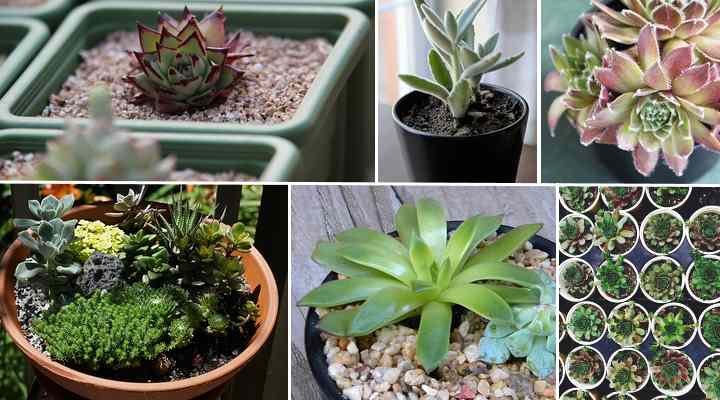
The best succulent soil mix should be well-draining and contain 1/2 to 2/3 of inorganic matter
The best succulent soil mix should be porous, light and airy. To make a succulent soil, amend your regular potting mix with at least 50 percent of inorganic matter. Ingredients such as coarse sand, perlite, or pumice make the succulent soil light and airy allowing water to drain freely.
You can experiment with other inorganic ingredients in your succulent soil mix such as crushed granite, small gravel chips, aquarium gravel, and poultry grit. It doesn’t matter which one you choose as long as it makes the succulent soil porous, light and airy.
As a general rule, ensure that inorganic content in the succulent soil mix is 1/2 to 2/3 for best results.
Why Regular Potting Soil is Bad for Succulents
Regular potting soil is not the right choice for succulents because it retains too much moisture, causing the plants to rot. Houseplant potting soil mostly contains organic material—bark, compost, and peat moss. The dense structure of organic matter doesn’t allow for suitable drainage and, therefore, doesn’t work for succulents.
Although succulents’ roots need hydrating occasionally, they start to decay in moisture. When the roots rot, the succulents can no longer feed, and the fleshy plants die.
Also, regular potting soil can become compacted relatively quickly. As the soil structure becomes denser, it holds more moisture and takes a longer time to dry. Damp, soggy soil is the worst type of growing medium for succulents.
The Best Soil for Succulents
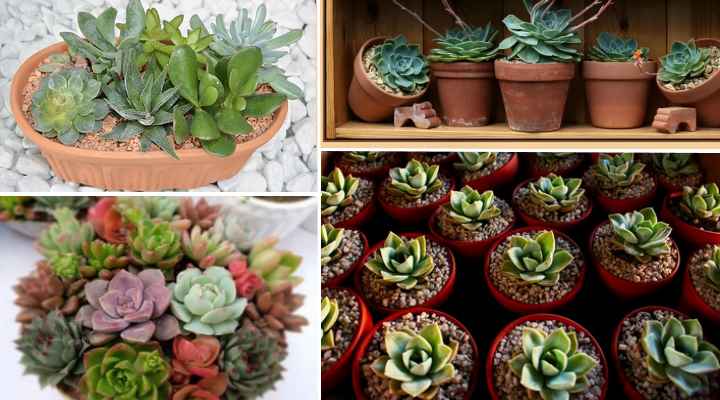
For DIY succulent soil mix 1/3 peat moss, bark chips or compost (organic matter) with 2/3 of sand, perlite, pumice or other inorganic matter
The best potting soil for succulents is a mixture of two-parts inorganic matter and one-part organic matter (2/3 inorganic matter and 1/3 organic matter). To create the ideal succulent mix, use regular potting mix. Then add perlite and coarse sand for drainage to create the perfect succulent soil mix.
Some organic matter is vital in any potting mix for succulents. Peat moss, bark chips, or compost contain nutrients to help plants such as cacti and succulents thrive. However, the moisture-retaining properties of organic material can be detrimental to succulent plant growth.
The best way to turn regular potting soil into an appropriate succulent mix is to aerate it with inorganic ingredients. By amending the soil with perlite, pumice, gravel, or sand, you allow more air in the soil, and the water drains faster.
The type of soil that is sandy with excellent drainage best mimics the native habit where succulents grow.
Common Ingredients in DIY Succulent Potting Soil Mix
The best succulent potting soil recipes use a mix of regular potting soil, perlite (or pumice), and coarse sand. The proportions for the homemade potting succulent mix should be around 2:1 inorganic matter to organic matter (2/3 inorganic matter and 1/3 organic matter). This combination of ingredients creates the most suitable medium for growing succulents.
Let’s look in more detail at why the right succulent mix needs plenty of sand and perlite with less potting soil.
Here are the ingredients in the DIY succulent soil:
Regular potting soil
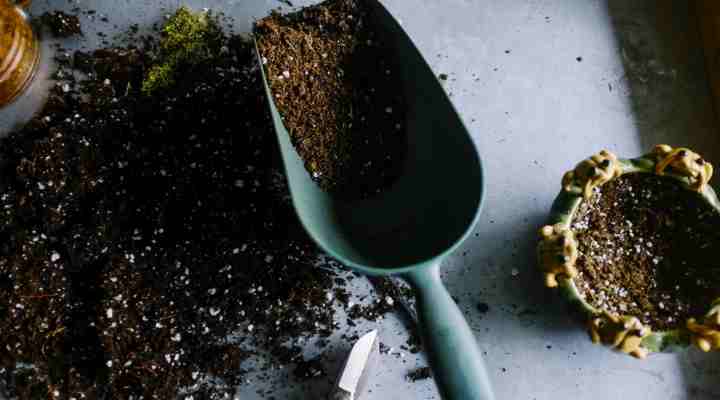
Most regular potting mix bought in garden stores contain organic matter which provides nutrients required for plants, as well as some inorganic matter for better drainage
The base for any succulent soil mix is a regular, all-purpose potting soil for houseplants. You can buy any plant potting soil as long as it’s sterile and fresh. You then amend the plant soil with inorganic material to create a light, porous mix for succulents.
It’s vital to remember not to use soil dug up from your garden as it may contain pests. The last thing your houseplant succulents need is to grow in a potting soil infested with gnats, mites, bugs, or other nasties.
To make a DIY succulent soil mix, you can use regular potting mix as the base, but further add perlite or coarse sand to create the best type of well-draining succulent soil.
Perlite or pumice
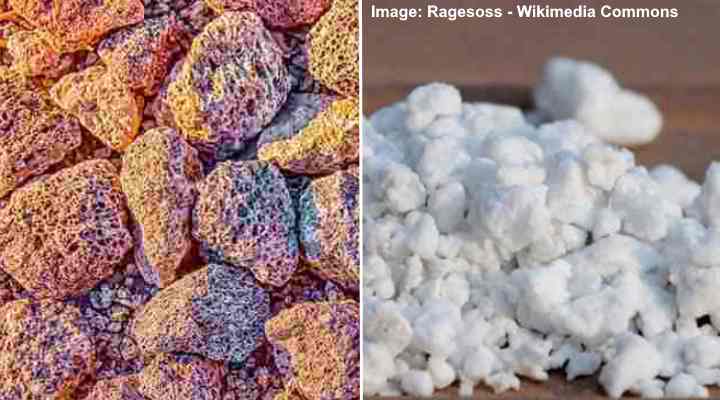
Pumice (left) and perlite (right)
Perlite is a natural soil amendment to create the ideal soil for succulents. Perlite looks like small Styrofoam balls but is a type of volcanic substance. The natural porous material is exceptionally lightweight and helps improve soil drainage and prevents compaction.
Although perlite is an inorganic substance, you can use if for growing succulent plants organically. Perlite is classed as inorganic because it doesn’t come from a living substance. During the production process, no chemicals or synthetic materials are used.
Pumice is another porous material that’s excellent for making succulent potting soil mix. This volcanic material can look like a hard, solid sponge. Adding pumice to potting soil helps to create the best type of soil for growing succulents and cacti. Similar to perlite, pumice doesn’t break down in the ground.
Another reason to use perlite or pumice for making a succulent potting mix is that it is an ideal soil amendment. In sandy soils, perlite and pumice help retain some moisture. However, in thick clay soil, the porous chips help reduce the density and increase drainage.
Perlite is the best choice for a succulent potting soil mix. The cheaper cost of perlite over pumice makes it perfect for amending soil.
You can buy perlite in most gardening stores, online, or in home improvement stores.
Coarse sand
Coarse sand is a vital ingredient in a suitable potting mix for succulents. Horticultural coarse sand breaks up dense potting soil to help attain the best growing medium for succulent plants.
The best choice of sand for your succulent mix is sterile, coarse sand. So, never use sand from the beach, a sandbox, or other similar sources. Like garden soil, you can’t be sure of what plant bugs are lurking there, ready to damage your succulent houseplants.
You can buy sand that is specially produced for growing succulents in pots. Look in garden centers or online for coarse sand for cacti, bonsai trees, or succulents.
If you can’t find coarse sand to add to your succulent mix, you could use alternatives such as poultry grit, aquarium gravel, or crushed granite. All you need is an inorganic matter that amends soil to allow water to drain freely.
How to Make Succulent Soil Mix – DIY Recipe

Making your own succulent soil mix ensures your succulents get enough nutrients while the soil is well-draining
It’s very straightforward to make a sandy, porous soil mix where succulents grow best. All you need is to mix three ingredients together.
Here is the recipe for making succulent soil:
- 2 parts regular potting soil
- 1 part horticultural sand
- 1 part perlite
It is easy to amend this succulent soil mix for growing cactus plants. To make the ideal potting soil mix for cacti, add one extra part of sand and one additional part of perlite to the succulent mix. A highly porous mix with super-fast drainage is best for growing cacti.
How to mix potting soil for growing succulents
To create your DIY cactus and succulent soil, put all the ingredients into a large bucket. Using a trowel or spade, thoroughly mix the soil/organic matter, sand, and perlite. Once the soil is mixed evenly, you are ready to plant your succulents in pots or an outdoor succulent garden.
A few comments about the DIY succulent soil
Regular potting soil mix already contains some inorganic ingredients such as perlite or vermiculite. As a result, the succulent soil mix will have more than 2 parts of inorganic ingredients because some are already included in the potting mix. So you don’t necessarily need to add more inorganic matter than what’s included in the recipe.
If you don’t use regular potting soil but instead use pure organic matter such as compost, or coconut coir then add more parts of inorganic ingredients to the soil mix. Use 1 part of pure organic matter, 1 part coarse sand, and 1 part perlite. This will make a succulent soil with 1 part organic matter and 2 parts of inorganic ingredients.
Read the complete guide to the best indoor plant fertilizers
Outdoor Soil for Succulents
The best soil for growing succulents outdoors must be gritty and porous with excellent draining. Succulents growing in the ground usually don’t require too much soil amendment, unless your soil has a poor drainage, such as clay soil. Outdoor succulents benefit from the sun that evaporates moisture fast and better airflow.
The best way to grow succulent plants outdoors is to create a rock garden with berms. Growing succulents on these raised beds allows for natural drainage. You can also create a loamy soil by working in coarse sand and perlite to the bed.
It’s best to grow succulents in pots outside if you have clay or dense soil. It might be too challenging to amend clay garden soil with sand and perlite. So, it’s usually easier to create an outdoor succulent garden in a large terracotta pot.
The Best Potting Soil Mix for Succulents to Purchase
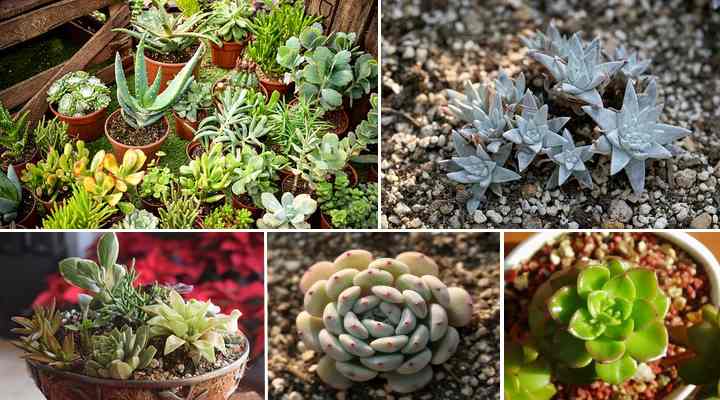
If you don’t want to make your own DIY succulent potting mix, you can buy ready-made succulent soil
Although it’s not difficult to make a potting soil mix to grow succulents, you can also buy commercially-produced products. Here are three examples of suitable succulent soil mixes:
Superfly Bonsai — This potting mix is ideal for growing succulents and cactus plants. The unique formula uses pine bark, pumice, and lightweight expanded clay chips to provide nutrients and drainage.
rePotme succulent blend mix — An excellent choice for growing cacti or succulents. Ground coconut husk is a soil replacement, and perlite, and pumice provide the succulent potting mix the best porous qualities.
You can purchase succulent potting soil mix in Amazon here.
How to Choose the Best Pots for Succulents
The best pots for growing succulent plants indoors or outdoors have drainage holes. Holes in the pot’s base allow for adequate root hydration but lets excess water pour out the bottom. If you have a non-draining pot, drill a hole in the base to avoid soggy, damp succulent soil.
Don’t make the mistake of adding a layer of rocks to a non-draining pot. Water collects in the bottom where bacteria thrive. The result is diseased roots, and your succulents will probably die. Even the best succulent soil won’t protect your plants from root rot if they sit in waterlogged soil.
Here is information about different types of pots for succulents:
- Terracotta or clay pots are the best pots for growing succulents. The porous material allows the potting mix to breathe and lets soil dry out faster.
- Plastic pots are the cheapest options for potted succulent plants. However, plastic tends to hold more moisture, so you have to water your succulents properly.
- Glazed ceramic pots are similar to plastic containers because they are excellent for holding moisture. Ensure that there’s a drainage hole for the best results.
When to Plant a Succulent in a New Potting Soil Mix
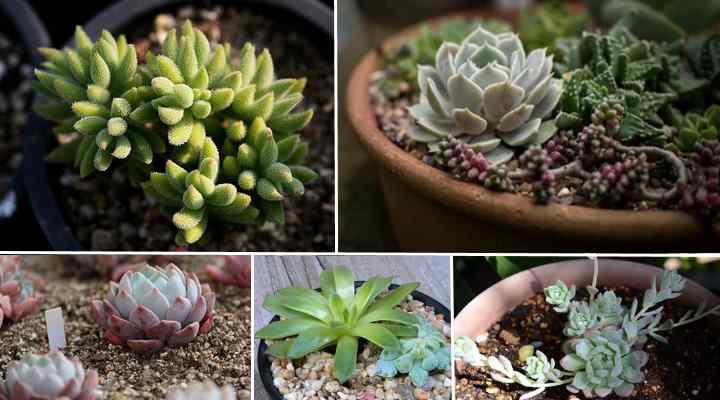
To care properly for your succulents, transplant them as soon as possible after buying them to ensure healthy growth
It’s best to plant succulents in a fresh potting soil mix when you bring them home. Stores rarely sell succulents in the best soil, and you can’t be sure how fresh or sterile the potting mix is. Replacing the succulent soil gives your plants the best chance of thriving.
Another reason to repot a succulent in a new potting soil mix is that it can be rootbound. Very often, the roots of store-bought succulents already fill the small pots. So, transferring the succulent to a new container is always best to encourage healthy growth.
Garden centers and nurseries often sell small succulents in a peat-based compost. While young succulents can grow in a peat soil mix, they won’t mature well. The dense growing medium leads to root rot and weak growth.
Remember, the best succulent soil mix is effortless to make at home. Transplanting succulents as soon as possible after buying them helps ensure healthy growth, plump, fleshy leaves, and that your succulent will grow for many years.
How to Transplant a Succulent in a New Potting Soil
Repot succulents every two years. Transferring succulent plants allows you to refresh the potting mix and increase pot size. Repotting with a suitable succulent mix boosts the nutrient content in the soil. Repot succulents at the start of the growing season in spring when growth is vigorous.
Here is how to transplant a succulent:
- Remove the succulent plant from its existing container.
- Shake off all dirt from the roots and cut off dead or decaying roots.
- Transplant to a new pot and fill with suitable potting soil mix for best results.
How to Water Succulents
The best way to water potted succulent plants is to drench the soil and then allow it to dry. Pour in enough water until it drains from the bottom of the pot. Allow all the excess water to drip out. Then water the succulent again when the soil potting mix dries.
The best succulent potting soil mix should dry out every two to three days. However, you generally have to water succulents less often.
Avoid the mistake of watering plants on a set schedule. Before you soak the soil, check to make sure the soil is completely dry. The temperature, air humidity, season, type of pot, and plant species all affect watering frequency.
Succulents are drought-tolerant plants. Some experts recommend watering succulents every ten to fourteen days. In time, you will see if watering succulents this often is enough. For example, in summer, you may have to water the plant more frequently. But in winter, your succulent requires very little—if any—watering.
Here are a few handy tips when it comes to watering potted succulents at home:
- Avoid splashing water on the fleshy succulent leaves—only water the potting soil mix.
- Don’t spray or mist succulent leaves.
- Always use the “soak and dry” method to provide deep watering.
- Succulents prefer sitting in dry, arid potting soil mix rather than one that’s continuously moist.
Watering succulents is rarely an issue when growing outdoors. The larger ground surface, warm sun, and airflow mean that the ground where succulents are growing dries out faster.
Read next: The Most Beautiful Succulents You Need to Grow (With Pictures)
Related articles:
